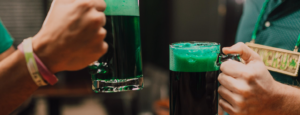As a fan of live music, and a musician myself, I recently made my way to the Fillmore Auditorium where the Brian Setzer’s Orchestra was performing. Brian Setzer has performed with a number of guitars, but his primary “ax” is a Gretsch “Hot Rod” – a flashy hollow-body that Setzer designed to his own specifications.
Gretsch markets and sells the “Hot Rod” as a signature model within the Brian Setzer series. Of course, as a consumer, you can only purchase a brand new “Hot Rod” at retail outlets like Guitar Center.
What’s this got to do with retail?
I wasn’t at Guitar Center when I recently encountered the “Hot Rod” – I was at the Fillmore. Prior to the acts beginning, I spotted a Gretsch Guitar “pop-up” display positioned around stage right. The pop-up featured a large graphic panel highlighting the cover of Brian Setzer’s latest CD and an even larger image of Brian himself cradling a vintage Gretsch guitar. Below was a rather large assortment of the Gretsch guitars – beautifully shimmering in a variety of luscious colors.
Neither Gretsch or Brian Setzer are brands of the masses – they can’t compete on that stage. To that end, marketing has to be targeted and the messaging truly engaging. Communicating within an active environment where consumer are open, receptive and can interact with the brands on a purely emotional level heightens consideration. Breaking through the clutter and noise at traditional retail outlets like Guitar Center or Virgin Music isn’t efficient for these brands or meaningful to the consumer.
While the messaging was specifically targeted at Setzer fans and Gretsch guitar enthusiast, the venue provided natural transitional moments (waiting for the show to start or that time between acts) where consumers felt comfortable interacting with the brand. How often do brands try to reach us when we are rushed or the setting isn’t natural?
Equally, how often do celebrities endorse brands where the endorsement feels neither real nor relevant? Is a Buick really the car of choice for Tiger Woods? He knows golf inside and out, but what is his credibility with cars?
Brian Setzer knows guitars. Brian Setzer designs guitars. Brian Setzer shreds a guitar like no one else. Brian Setzer plays Gretsch. I get it. I believe it.
So, to rephrase the question – is this retail?
At The Integer Group, we have started to think of retail as:
“Any environment (physical or virtual) that has been constructed to process or facilitate an exchange of items of value (transaction).”
This certainly was a physical environment and the intent was to elicit a transaction between audience and brand – I gave my time and Gretsch allowed me an intimate product experience. I also gave something else. Next to the row of glittering guitars was a computer kiosk. Many of us enthusiastically gave away our names, addresses and e-mail addresses for a chance at winning a Brian Setzer autographed signature Gretsch.
Later comes the true test of audience/brand engagement. Buying a Gretsch represents a high involvement purchase – they run about $3,000. None of us at the Fillmore were prepared to pull out our debit cards and take one home, but I imagine (and hope) I will soon start getting e-mails and further messages from Gretsch as they have now pegged me as someone hopelessly climbing from consideration (yeah I would like one) to intent (damn, I need one).
Gretsch wasn’t selling that night and no one was making a purchase. What they did do was to place a permanent brand image squarely within the right hemisphere of my brain – the part where creativity flourishes and any inkling of reason and rational decision-making is noticeably absent. For me, my aspiration of owning a Gretsch is the epitome of practicality. It makes all the sense in the world.
No, they weren’t selling that night, but I was buying – buying into the realization that I really needed that guitar.
Now that’s retailing.
– Contributed by Paul Ballew

